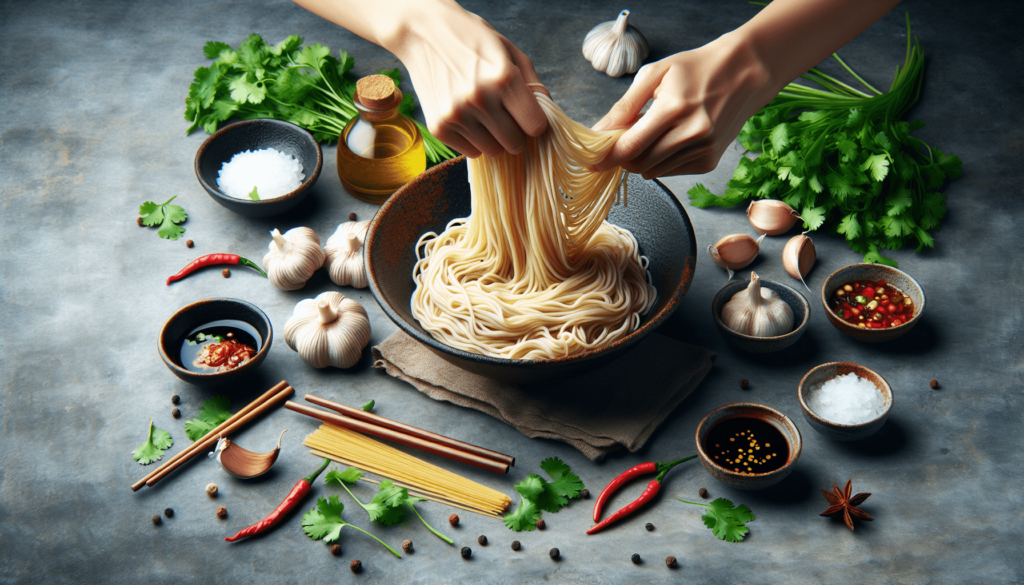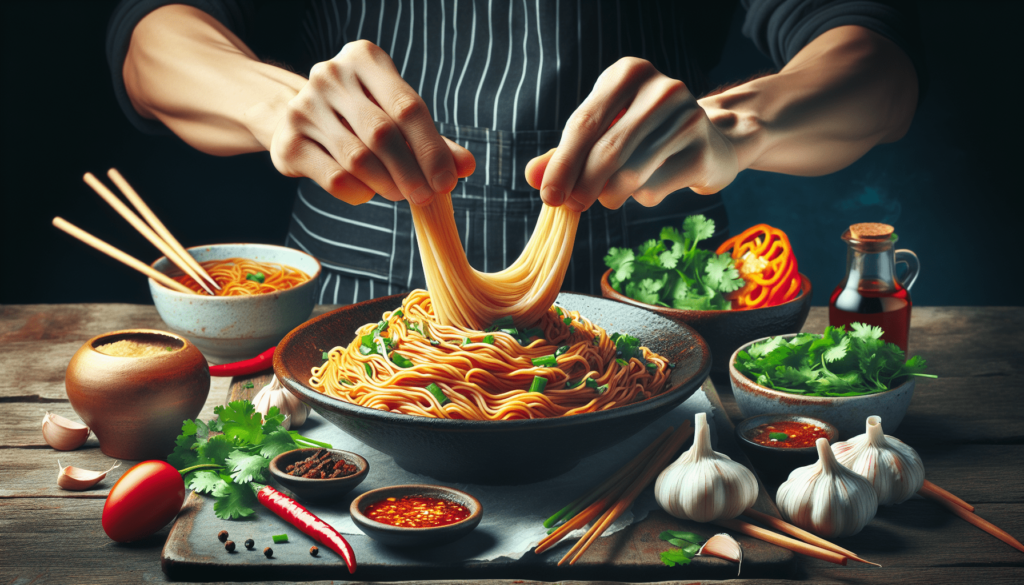Are you ready to embark on a delicious culinary journey? Get ready to tantalize your taste buds with a variety of mouth-watering Biangbiang Noodles recipes. Originating from the Shaanxi province in China, these wide, hand-pulled noodles are renowned for their incredible texture and rich flavors. Whether you prefer a spicy Sichuan-style stir fry or a savory soy-based broth, this article will guide you through the steps to create your own delectable Biangbiang Noodles dishes. Get your chopsticks ready and let’s dive into the world of Biangbiang Noodles recipes!

What are Biangbiang Noodles?
Biangbiang noodles are a type of hand-pulled noodles that originated in the Shaanxi province of China. These noodles are known for their wide and thick shape, which sets them apart from other types of noodles. Biangbiang noodles are made from wheat flour and water, creating a dough that is then stretched and pulled by hand to form the long, flat strands.
Origin
The exact origin of biangbiang noodles is uncertain, but it is believed that they have been a staple food in the Shaanxi province for centuries. The name “biangbiang” comes from the sound that is made when the dough is slapped against the counter during the hand-pulling process.
Description
Biangbiang noodles are characterized by their wide and thick shape, which can be as wide as a belt and as long as an arm. The texture of biangbiang noodles is chewy and slightly slippery, which allows them to absorb the flavors of sauces and seasonings. These noodles are typically served with a variety of toppings and sauces, making for a hearty and satisfying meal.
Characteristics
The unique characteristics of biangbiang noodles make them stand out from other types of noodles. The width and thickness of these noodles give them a substantial and satisfying bite. Additionally, the hand-pulled nature of biangbiang noodles creates a unique texture that is both chewy and tender. These noodles are also known for their ability to hold up well to strong and bold flavors, making them a versatile choice for a range of dishes.
Traditional Biangbiang Noodles Recipe
Ingredients
- 2 cups all-purpose flour
- 1 cup water
- 1 tablespoon vegetable oil
- Salt to taste
Instructions
- In a large mixing bowl, combine the flour and salt.
- Gradually add water to the flour mixture, stirring until a dough forms.
- Knead the dough for about 10 minutes until it becomes smooth and elastic.
- Divide the dough into small portions and roll each portion into a long, thin rope.
- Take one end of the dough rope and twist it around your hand, forming a loop.
- Slap the dough against the counter to stretch it into a wide and thin noodle.
- Repeat the process with the remaining dough portions.
- Boil the noodles in a pot of salted water for 5-7 minutes until they are cooked through.
- Drain the noodles and toss them in vegetable oil to prevent sticking.
- Serve the biangbiang noodles with your favorite sauce and toppings.
Variations of Biangbiang Noodles
Spicy Cumin Beef Biangbiang Noodles
This variation of biangbiang noodles features tender beef cooked with a spicy cumin sauce. The beef is thinly sliced and stir-fried with garlic, cumin, chili peppers, and other aromatic spices. The noodles are then tossed in the spicy beef sauce, creating a fiery and flavorful dish.
Vegetarian Mushroom Biangbiang Noodles
For those who prefer a vegetarian option, mushroom biangbiang noodles are a delicious choice. The noodles are paired with a medley of sautéed mushrooms, including shiitake, oyster, and enoki mushrooms. The mushrooms are tossed in a savory sauce made from soy sauce, sesame oil, and garlic, creating a satisfying umami flavor.
Sichuan Dan Dan Biangbiang Noodles
Sichuan dan dan biangbiang noodles are a popular spicy noodle dish originating from the Sichuan province of China. The noodles are served in a spicy chili oil sauce and topped with minced pork, green onions, and peanuts. The combination of spicy, nutty, and savory flavors makes this dish irresistible to spice lovers.
Sesame Sauce Biangbiang Noodles
Sesame sauce biangbiang noodles are a classic and simple preparation of this beloved noodle dish. The noodles are tossed in a creamy sesame sauce made from sesame paste, soy sauce, vinegar, and sugar. This dish is often garnished with green onions and roasted sesame seeds for added flavor and texture.

Tips for Perfect Biangbiang Noodles
Choosing the Right Noodles
When making biangbiang noodles, it is important to use a high-quality wheat flour to ensure the best texture and taste. Look for flour that is specifically labeled for noodle-making or bread-making to achieve the desired chewiness.
Preparing the Dough
The key to making great biangbiang noodles is in the dough. Kneading the dough thoroughly and allowing it to rest before pulling will result in a more elastic and easy-to-work-with dough. Resting the dough also allows the gluten to develop, giving the noodles a better texture.
Mastering the Hand-Pulling Technique
Pulling the biangbiang noodles by hand takes practice and patience. Begin by rolling out the dough into long ropes, and then twist the dough around your hand to form a loop. Slap the dough against the counter to stretch it into wide and thin noodles. The pulling motion should be quick and forceful to achieve the desired thickness.
Cooking Time and Temperature
To ensure that the biangbiang noodles are cooked properly, it is important to boil them for the right amount of time. Follow the instructions on the recipe you are using, but generally, biangbiang noodles should be boiled for 5-7 minutes until they are al dente. Be sure to taste the noodles before removing them from the water to avoid overcooking.
Serving Suggestions
Biangbiang noodles can be served in a variety of ways, depending on personal preference. They can be topped with a range of ingredients, such as stir-fried vegetables, braised meats, or a flavorful sauce. Some popular toppings include sautéed bok choy, shredded chicken, pickled cabbage, or a combination of spicy chili oil, soy sauce, and vinegar.
Biangbiang Noodles in Popular Culture
Biangbiang Noodles in Movies and TV Shows
Biangbiang noodles have made appearances in various Chinese movies and TV shows, often being depicted as a beloved local street food. These scenes often highlight the hand-pulling technique and the wide, belt-like shape of the noodles, showcasing the skill and craftsmanship required to make biangbiang noodles.
Biangbiang Noodles in Chinese Literature
Biangbiang noodles have also been mentioned in Chinese literature, particularly in poems and novels that depict the daily life and culinary culture of the Shaanxi province. These references add to the cultural significance and historical importance of biangbiang noodles as a traditional dish in the region.
Biangbiang Noodles as a Cultural Symbol
Biangbiang noodles are not just a delicious food, but also a cultural symbol that represents the importance of craftsmanship, tradition, and regional identity. The hand-pulling technique and the name “biangbiang” itself exemplify the unique cultural heritage of the Shaanxi province and its culinary contributions to Chinese cuisine.
Health Benefits of Biangbiang Noodles
Nutritional Value
Biangbiang noodles are made from wheat flour, which is a good source of complex carbohydrates and dietary fiber. They are also low in fat and cholesterol-free, making them a healthier choice compared to fried noodles or processed alternatives. Biangbiang noodles are particularly rich in B vitamins, iron, and magnesium.
Digestive Health
The fiber content in biangbiang noodles promotes healthy digestion and aids in preventing constipation. The chewy texture of these noodles also requires more effort to eat, which can help slow down the eating process and promote satiety.
Energy Boost
The complex carbohydrates in biangbiang noodles provide a steady release of energy, making them an excellent choice for fueling physical activity or maintaining energy levels throughout the day. These noodles are often enjoyed as a filling and satisfying meal, keeping you energized and satisfied for longer periods.
Weight Management
Biangbiang noodles are a filling and low-calorie option compared to other types of noodles or pasta. Their high fiber content can help control appetite and prevent overeating. When paired with a variety of vegetables and lean proteins, biangbiang noodles can be part of a balanced and nutritious meal for weight management.
Regional Varieties of Biangbiang Noodles
Shaanxi-style Biangbiang Noodles
Shaanxi-style biangbiang noodles remain true to their origins in the Shaanxi province. These noodles are typically wide, thick, and served with a savory, meat-based sauce. Popular toppings include braised pork, sautéed vegetables, and a variety of soy-based seasonings.
Sichuan-style Biangbiang Noodles
Sichuan-style biangbiang noodles incorporate the bold and spicy flavors of Sichuan cuisine. These noodles are often topped with a combination of chili oil, Sichuan peppercorns, and minced pork, creating a numbingly hot and addictive dish that is well-loved by spice enthusiasts.
Henan-style Biangbiang Noodles
Henan-style biangbiang noodles are known for their simplicity and focus on the quality of the noodles themselves. These noodles are typically served with a light soy-based sauce and minimal toppings, allowing the flavors of the noodles to shine through.
Xinjiang-style Biangbiang Noodles
Xinjiang-style biangbiang noodles are influenced by the cuisine of the Xinjiang region in China, which has strong Central Asian and Middle Eastern flavors. These noodles are often paired with lamb, cumin, and a variety of aromatic spices that create a unique and flavorful dish.
Where to Find Biangbiang Noodles
Popular Chinese Restaurants
Biangbiang noodles can be found in many Chinese restaurants, especially those that specialize in dishes from the Shaanxi or Sichuan provinces. These restaurants often have skilled chefs who are able to hand-pull the noodles and prepare them with authentic flavors and techniques.
Street Food Stalls
In China, biangbiang noodles are often sold at street food stalls, where they are made fresh and served hot. These stalls are a popular spot for locals and tourists alike to enjoy this beloved dish, as it offers a quick and convenient meal that is full of flavor and texture.
Home Cooking
For those who enjoy cooking at home, making biangbiang noodles from scratch can be a fun and rewarding experience. The ingredients are readily available in most grocery stores, and there are many recipes and tutorials available online to guide you through the process. By making biangbiang noodles at home, you can customize the flavors and toppings to suit your preferences.
Culinary Influences on Biangbiang Noodles
Regional Cuisine
The culinary influences on biangbiang noodles can be seen through the various regional variations of the dish. Different provinces in China have their own unique flavor profiles and ingredients that they incorporate into their version of biangbiang noodles, resulting in a diverse and vibrant culinary landscape.
Street Food Culture
Street food culture has also played a significant role in shaping the popularity and accessibility of biangbiang noodles. Street food stalls have made this dish easily accessible to people from all walks of life, allowing them to experience the flavors and techniques of biangbiang noodles without the need for a formal restaurant setting.
Immigrant Influence
As Chinese cuisine has spread around the world, biangbiang noodles have gained popularity in Chinese immigrant communities. These communities have brought their culinary traditions with them and have adapted recipes to local ingredients, resulting in unique variations of this beloved dish that can be found in Chinese restaurants around the globe.
Conclusion
Biangbiang noodles are a versatile and delicious dish that has earned its place as a beloved staple in Chinese cuisine. Their wide and thick shape, combined with their chewy texture, make them a unique and satisfying choice for noodle lovers. Whether enjoyed in a traditional sauce or with modern variations, biangbiang noodles offer a cultural and culinary experience that is worth exploring. So, grab your chopsticks and try this must-try dish that is steeped in tradition and rich in flavor.


